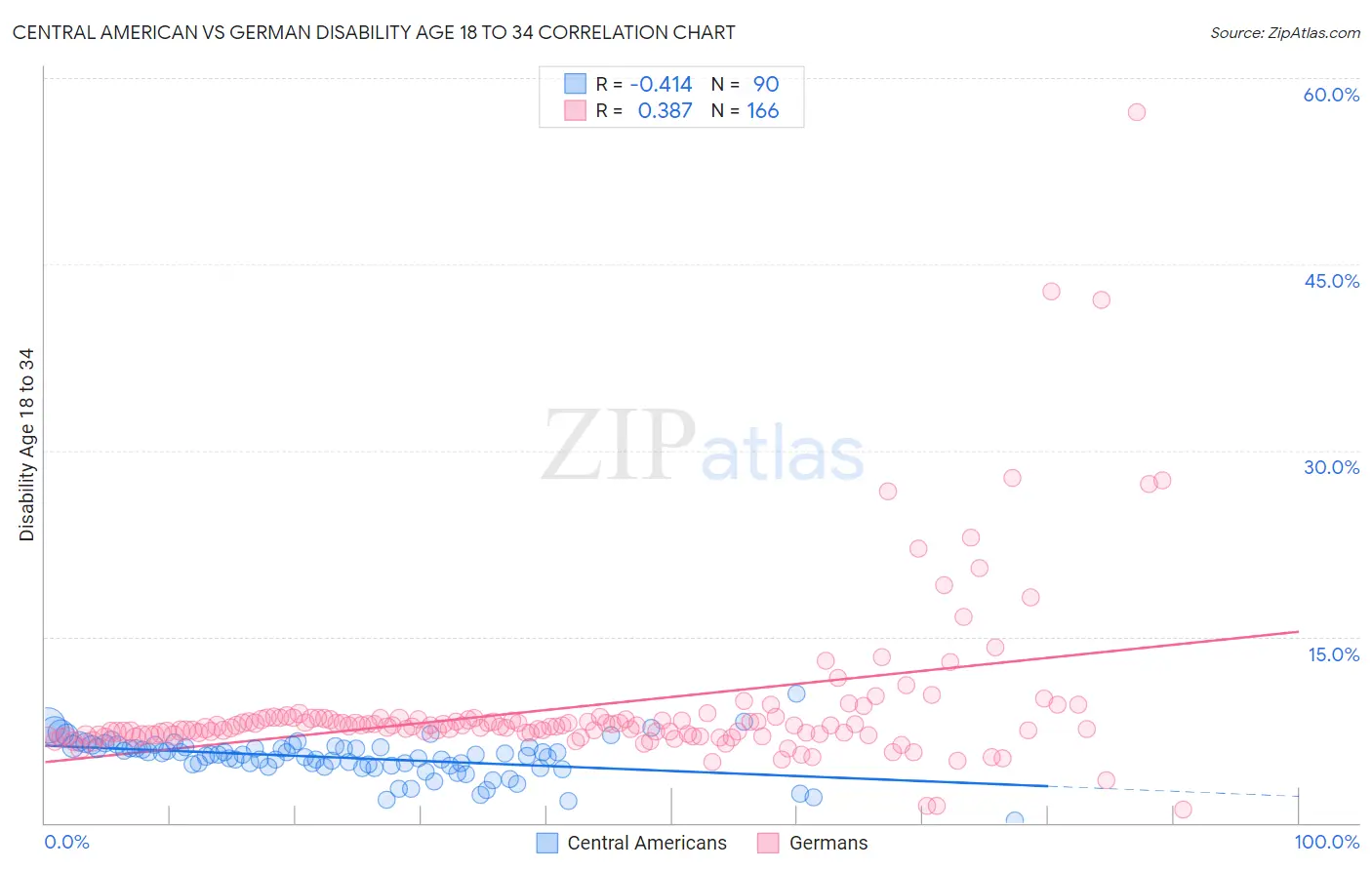Central American vs German Disability Age 18 to 34
COMPARE
Central American
German
Disability Age 18 to 34
Disability Age 18 to 34 Comparison
Central Americans
Germans
6.2%
DISABILITY AGE 18 TO 34
97.5/ 100
METRIC RATING
95th/ 347
METRIC RANK
7.7%
DISABILITY AGE 18 TO 34
0.0/ 100
METRIC RATING
299th/ 347
METRIC RANK
Central American vs German Disability Age 18 to 34 Correlation Chart
The statistical analysis conducted on geographies consisting of 502,711,138 people shows a moderate negative correlation between the proportion of Central Americans and percentage of population with a disability between the ages 18 and 35 in the United States with a correlation coefficient (R) of -0.414 and weighted average of 6.2%. Similarly, the statistical analysis conducted on geographies consisting of 573,263,682 people shows a mild positive correlation between the proportion of Germans and percentage of population with a disability between the ages 18 and 35 in the United States with a correlation coefficient (R) of 0.387 and weighted average of 7.7%, a difference of 25.0%.

Disability Age 18 to 34 Correlation Summary
| Measurement | Central American | German |
| Minimum | 0.22% | 1.1% |
| Maximum | 10.4% | 57.2% |
| Range | 10.2% | 56.1% |
| Mean | 5.3% | 9.3% |
| Median | 5.5% | 7.8% |
| Interquartile 25% (IQ1) | 4.6% | 7.1% |
| Interquartile 75% (IQ3) | 6.1% | 8.4% |
| Interquartile Range (IQR) | 1.5% | 1.3% |
| Standard Deviation (Sample) | 1.5% | 6.7% |
| Standard Deviation (Population) | 1.5% | 6.7% |
Similar Demographics by Disability Age 18 to 34
Demographics Similar to Central Americans by Disability Age 18 to 34
In terms of disability age 18 to 34, the demographic groups most similar to Central Americans are Immigrants from Kazakhstan (6.2%, a difference of 0.030%), Immigrants from Uruguay (6.2%, a difference of 0.050%), Immigrants (6.2%, a difference of 0.080%), Jordanian (6.2%, a difference of 0.10%), and Uruguayan (6.2%, a difference of 0.13%).
| Demographics | Rating | Rank | Disability Age 18 to 34 |
| Cambodians | 97.8 /100 | #88 | Exceptional 6.2% |
| Turks | 97.8 /100 | #89 | Exceptional 6.2% |
| Immigrants | Vietnam | 97.7 /100 | #90 | Exceptional 6.2% |
| Immigrants | Philippines | 97.6 /100 | #91 | Exceptional 6.2% |
| Jordanians | 97.6 /100 | #92 | Exceptional 6.2% |
| Immigrants | Immigrants | 97.6 /100 | #93 | Exceptional 6.2% |
| Immigrants | Kazakhstan | 97.5 /100 | #94 | Exceptional 6.2% |
| Central Americans | 97.5 /100 | #95 | Exceptional 6.2% |
| Immigrants | Uruguay | 97.4 /100 | #96 | Exceptional 6.2% |
| Uruguayans | 97.3 /100 | #97 | Exceptional 6.2% |
| Immigrants | Syria | 97.2 /100 | #98 | Exceptional 6.2% |
| Immigrants | Ethiopia | 96.9 /100 | #99 | Exceptional 6.2% |
| Immigrants | Albania | 96.7 /100 | #100 | Exceptional 6.2% |
| Immigrants | Jamaica | 96.4 /100 | #101 | Exceptional 6.2% |
| Laotians | 96.4 /100 | #102 | Exceptional 6.2% |
Demographics Similar to Germans by Disability Age 18 to 34
In terms of disability age 18 to 34, the demographic groups most similar to Germans are Scottish (7.7%, a difference of 0.010%), Pima (7.7%, a difference of 0.080%), Welsh (7.7%, a difference of 0.15%), Cheyenne (7.7%, a difference of 0.21%), and Dutch (7.7%, a difference of 0.24%).
| Demographics | Rating | Rank | Disability Age 18 to 34 |
| Blacks/African Americans | 0.0 /100 | #292 | Tragic 7.7% |
| Scandinavians | 0.0 /100 | #293 | Tragic 7.7% |
| Immigrants | Cabo Verde | 0.0 /100 | #294 | Tragic 7.7% |
| Tlingit-Haida | 0.0 /100 | #295 | Tragic 7.7% |
| Cape Verdeans | 0.0 /100 | #296 | Tragic 7.7% |
| Pueblo | 0.0 /100 | #297 | Tragic 7.7% |
| Dutch | 0.0 /100 | #298 | Tragic 7.7% |
| Germans | 0.0 /100 | #299 | Tragic 7.7% |
| Scottish | 0.0 /100 | #300 | Tragic 7.7% |
| Pima | 0.0 /100 | #301 | Tragic 7.7% |
| Welsh | 0.0 /100 | #302 | Tragic 7.7% |
| Cheyenne | 0.0 /100 | #303 | Tragic 7.7% |
| Shoshone | 0.0 /100 | #304 | Tragic 7.8% |
| Menominee | 0.0 /100 | #305 | Tragic 7.8% |
| English | 0.0 /100 | #306 | Tragic 7.8% |